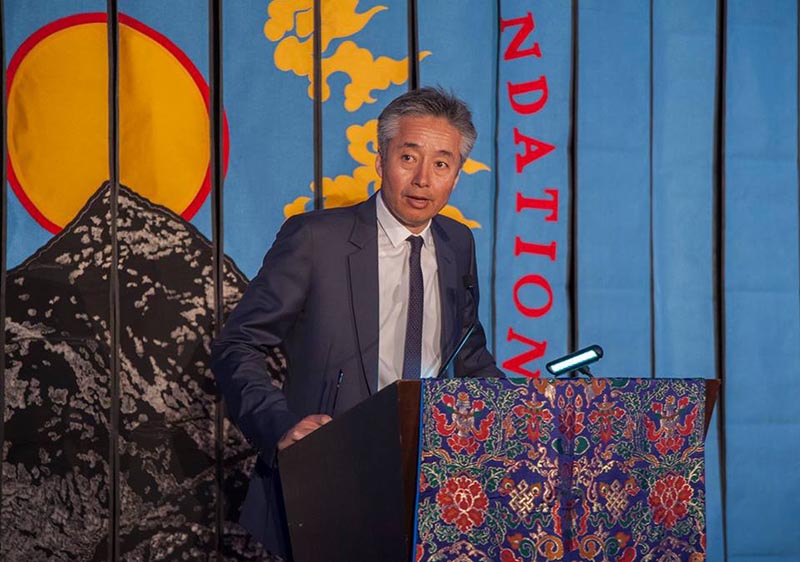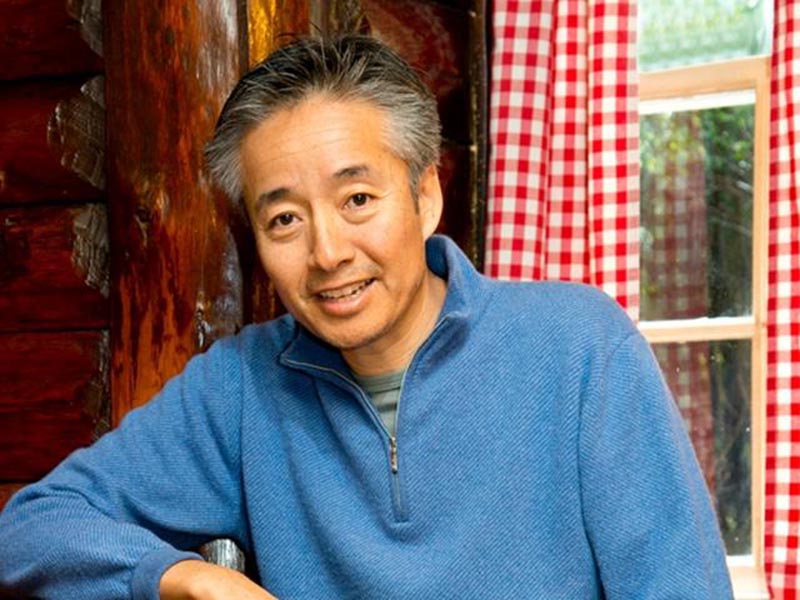Denying summit certificates an insult to Sherpas, says Norbu Tenzing Norgay
For a true mountaineer, the pride and satisfaction of reaching a summit is far more important than a paper issued by a government office
Norbu Tenzing Norgay, the eldest son of Tenzing Norgay Sherpa, who climbed Mt Everest with Sir Edmund Hillary in 1953, has said that the government’s move to bar Sherpa climbers from obtaining summit certificates only adds insult to injury for the unsung heroes of mountain climbing.
Sharing his thoughts with this daily, Norbu, 54, who was recently spotted in Kathmandu, opined that everyone associated with the mountaineering industry, including expedition companies, climbers and associations should speak up for Sherpa climbers who have been denied summit certificates by the government.
“To the outside world it appears silly and by not giving certificates to summiteers it only adds insult to injury for summiteers who labour under dangerous circumstances, bear a disproportionate amount of risk and are under-compensated in many instances,” he said, adding that he saw no reason not to support Sherpa climbers. “For a true mountaineer, the pride and satisfaction of reaching a summit is far more important than a paper issued by a government office.”
Norbu, who is also an advocate for reducing risk on Mt Everest, further said Sherpas needed to overcome the client or guide mentality and be able to take charge when necessary. “The paying clients need to understand that a qualified Sherpa’s decisions on safety are as valid as those of the expedition leader.”
Since Mt Everest has largely become a bucket list tourist destination, Nepalis, including Sherpa operators, rightfully want a bigger piece of the Everest pie, he said.
According to him, high altitude Sherpas and mountaineering workers are in an awkward spot where they risk losing their jobs if they speak up with every Sherpa family agonising with loss of a loved one on the mountains and the devastating impact it has on the family. “My family is no exception and this issue of risk and inequity is never far from our minds,” he said.
But, it took a massive disaster like the one in 2014 which killed 16 Sherpas in the icefall for the world to finally see what was going on. “The life insurance is up to $15,000 (up from $10,000) which is barely enough to pay for the funeral expenses and not much has changed.”
It’s safe to say that ‘traditional alpinism’ rarely exists in the mountains of Nepal. “But the bucket list mentality and the desire to set new records makes Mt Everest a focus for everyone, even non-climbers,” he noted. Mt Everest is for everyone and no one should be denied to climb it. “Just do it responsibly and just as you would boycott a product because of bad business ethics, do your homework before you choose whom you go with; this could mean the difference between life and death.”
After all Nepal has been richly endowed with the most spectacular mountains in the world, but we need to be good stewards of these natural treasures. “I think we can all benefit but significant change can only happen with a combination of self-regulation, involvement of the Sherpa community and if there is someone powerful locally to take on the industry,” he said.
Norbu Tenzing Norgay, the eldest son of Tenzing Norgay Sherpa, who climbed Mt Everest with Sir Edmund Hillary in 1953, talked to Rajan Pokhrel of The Himalayan Times about the government’s move to bar Sherpa climbers from obtaining summit certificates. Excerpts:
This year too, Sherpa climbers who stood atop Mt Everest assisting foreigners have not been given certificates till date. What do you want to say to the government, mountaineering and expedition associations among others on the issue?
I’d like to preface by saying that I am not a climber nor am I involved in the expedition business. But like many Sherpas, I come from a family of climbers and have some understanding of the issues faced by Sherpas who make a living on the mountains.
From what I understand, the government issues these summit certificates which for many Sherpa summiteers is a source of pride and displayed in frames at their home. I don't know what the politics behind the certificate issue is. To the outside world it appears silly and by not giving certificates for summiteers it only adds insult to injury for the summiteers who labor under very dangerous circumstances, bear a disproportionate amount of the risk and are under compensated in many instances. Everyone associated with the industry including expedition companies, climbers and the various associations should speak up for these unsung heroes. I see no reason not to support issuing certificates to the Sherpa climbers who summit. For a true mountaineer, the pride and satisfaction of reaching a summit is far more important that a paper issued by a government office. Being included in Elizabeth Hawley's Himalayan Database is the best public record of an Everest ascent.

Unhealthy competition among the guiding companies has reportedly been encouraging inexperienced climbers to attempt to the Mt Everest summit. Ultimately such acts put the Sherpas´ lives at risk. How can safety and security for the Sherpa support staff be ensured?
Yes, a good example is the incident this season involving the severely frostbitten Sange Sherpa who almost died because his client insisted on going to the top against Sanges (who was his guide) better judgment. Since Mt Everest has largely become a bucket list tourist destination, there is an insatiable appetite for those who want to climb it. So the demand is there and Nepalis and Sherpa operators rightfully want a bigger piece of the Everest pie. When people pay between $25,000 to $100,000 plus to make it the top, they are buying a very expensive service and they obviously expect a solid return. Your success as a company next year is often judged by your success this year. And you don't always get what you pay for.
The mix of greed, inequity, inexperience and lack of proper oversight will do irreparable damage. Mind you, there are good operators but as in every industry there are less credible ones as well. And there is a culture of money being made in every chain link of the industry. I've even heard of longer than necessary stays at a certain hospital for injured climbers with kickbacks from hospitals to those who bring the patients in. This obviously results in patients getting sent to the wrong hospitals with little or no knowledge for that particular treatment.
Essentially, there is total lack of political will to make any change so the status quo remains. One way forward is to self-regulate and have the Sherpa community take more ownership for the long term future of the mountain. Again, the government bears the brunt of the blame here, and deservedly so. However, local operators in Kathmandu have a big influence on the decisions made by the Nepal government, and most have chosen to let the status quo remain.
On the issue of safety and security, Sherpas are making advances with places like the Khumbu Climbing Center and other programs from Nepal Mountaineering Association providing much needed training for the Sherpas who want to professionalize their skills.
There are increasingly more Sherpas who are highly trained and making inroads as guides not only in Nepal, but also in Western Europe and the United States. I'm especially proud of Sherpanis like Pasang Lhamu Sherpa Akita and Dawa Yangzum Sherpa who are in par with their male counterparts. Sherpas need to overcome the client/guide mentality and be able to take charge when necessary. The paying clients need to understand that a qualified Sherpa's decisions on safely are as valid as those of the expedition leader.
Have insurance coverage, perks and facilities being provided to support staff been enough?
The high altitude Sherpas and mountaineering workers are in an awkward spot where they risk losing their jobs if they speak up. Every Sherpa family has agonized with loss of a loved one on the mountains and the devastating impact it has on the family. My family is no exception and this issue of risk and inequity is never far from our minds. But it took a massive disaster like the one in 2014 which killed 16 Sherpas in the icefall for the world to finally see what was going on. The life insurance is up to $15,000 (up from $10,000) which is barely enough to pay for the funeral expenses. Not much has changed in the big scheme of things.
What´s your observation regarding the future of mountain climbing in Nepal? What´s your take on crowd on Mt Everest as most of the climbers give up traditional alpinism?
There are many beautiful mountains and adventures to experience in Nepal. There are no limits to the future of mountaineering in Nepal. After all Nepal has been richly endowed with most spectacular mountains in the world but we need to be good stewards of these natural treasures. I think we can all benefit but significant change can only happen with a combination of self-regulation, involvement of the Sherpa community and if there is someone powerful locally to take on the industry.
It's safe to say that "traditional alpinism" rarely exists in the mountains of Nepal. But the bucket list mentality and desire to set new records, makes Mt Everest a focus for everyone, even non climbers. No true alpinist would queue to stand on a summit, but there is only one ‘highest’ mountain and that is a big attraction. Six of the next seven highest peaks are in Nepal, but they are not number one and few people are attracted to them. However, even the most experienced climbers from the West, routinely hire Sherpas to break trails and fix ropes even on mountains lower than 8,000 meters.
Mt Everest is for everyone and no one should be denied to climb it. Just do it responsibly and just as you would boycott a product because of bad business ethics, do your homework before you choose whom you go with. This could mean the difference between life and death.
(The views expressed in this interview are his personal views as an advocate for safety and equity for high altitude mountaineers.)



